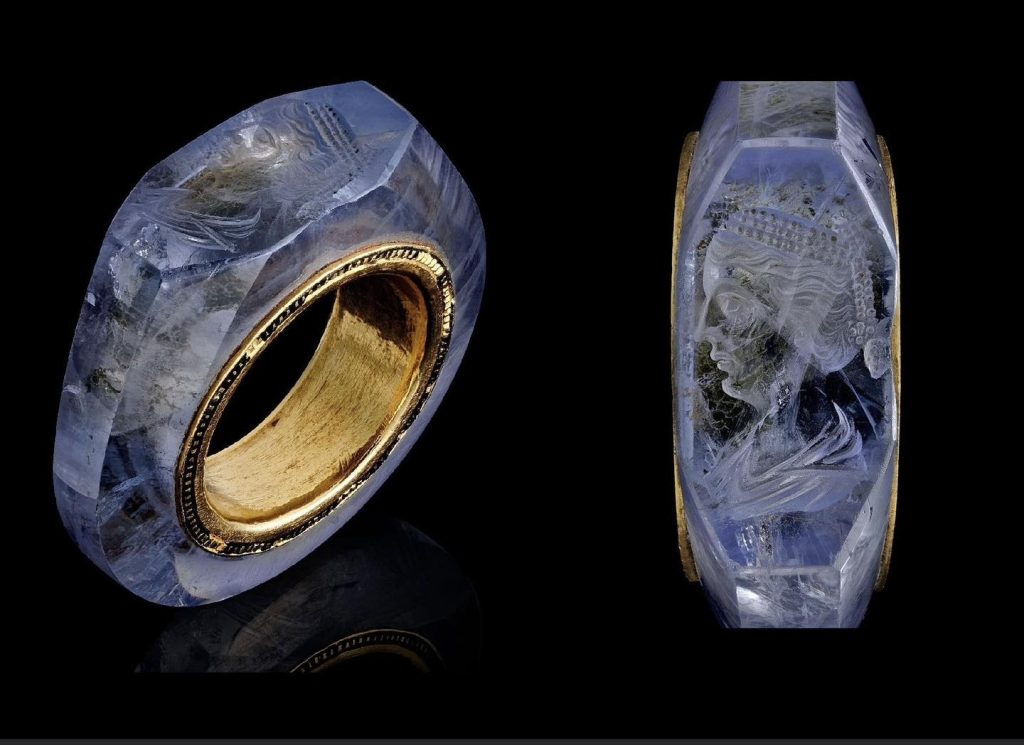Among the many exquisite artifacts from the Roman Empire, few rival the sheer magnificence of a sapphire ring believed to have once belonged to Emperor Caligula. This extraordinary piece, over 2,000 years old, is not merely a stunning example of ancient craftsmanship but also a fascinating historical relic that offers insight into the opulence and personal life of one of Rome’s most infamous rulers.

The ring, crafted with exceptional precision, features a deep blue sapphire, skillfully carved with the portrait of a woman thought to be Caesonia, Caligula’s fourth wife. This remarkable gemstone, set in a band of gold, represents not only the luxurious taste of Rome’s elite but also the deep significance of gemstones in Roman society. Sapphire, revered for its divine beauty and association with protection and wisdom, was particularly cherished by the ruling class.
Caligula, officially known as Gaius Julius Caesar Augustus Germanicus, reigned as the third emperor of Rome from AD 37 to AD 41. His rule was marked by excess, scandal, and controversy, yet his personal relationships, especially with Caesonia, have captivated historians for centuries. Caesonia, described by contemporary sources as both beautiful and extravagant, held significant influence over the emperor. According to ancient accounts, Caligula was deeply infatuated with her, showering her with lavish gifts and public displays of affection.
The sapphire ring is a testament to this passionate relationship. In Roman times, personalized jewelry was not uncommon among the elite. Engraved gemstones, known as intaglios, were often used to depict gods, political figures, or loved ones. Such rings served as personal symbols of status, devotion, and identity. Given the intricacy and refinement of the carving, scholars believe that the portrait on this sapphire ring was intended to honor Caesonia, demonstrating the emperor’s admiration for her.
Ancient Romans held sapphires in high esteem, importing them from regions as distant as Sri Lanka. These gemstones symbolized power, purity, and divine favor. They were thought to provide protection against harm, making them a favored choice among Rome’s elite. The craftsmanship of this ring suggests that it was created by one of the era’s most skilled artisans, further reinforcing the idea that it was a personal treasure of immense value.
Caligula’s rule, despite its opulence, ended in tragedy. His extravagant and often erratic behavior led to widespread discontent among Rome’s elite and the Praetorian Guard, the emperor’s supposed protectors. In AD 41, he was assassinated in a violent coup, and shortly after, Caesonia and their young daughter suffered a similar fate. The execution of his family was an attempt to erase his lineage and secure political stability.
Given these events, the survival of this ring is remarkable. Many of Caligula’s personal possessions were likely confiscated, destroyed, or lost over time. The ring’s journey from the imperial palace to the present remains a mystery, but its survival underscores the enduring allure of ancient Roman artifacts.
Archaeologists and historians have long debated the provenance of the sapphire ring. Some believe it was recovered from an imperial hoard, while others speculate that it was passed down through generations of noble families before resurfacing in modern times. Regardless of its path, the ring provides a tangible connection to one of history’s most infamous emperors and his equally intriguing wife.
The significance of this artifact extends beyond its association with Caligula. It offers a glimpse into the artistry of Roman gem engraving, a highly sophisticated craft that required exceptional skill and precision. The technique used to carve the sapphire—a hard and difficult stone to work with—suggests that only the most accomplished artisans of the time could have produced such a masterpiece.
Moreover, this ring represents the grandeur of Rome’s imperial court. The possession of such a jewel would have signified immense wealth and power, reinforcing the notion that Rome’s rulers lived in unparalleled luxury. For modern scholars, it serves as a window into the aesthetics, social customs, and personal expressions of the ancient world.
The study of artifacts like this ring is crucial in piecing together the personal lives of historical figures. While written records about Caligula and Caesonia provide fragmented and often biased perspectives, objects like this offer a more tangible and unbiased view of the past. Jewelry, in particular, serves as an intimate relic, carrying the essence of its wearer in a way that written history often fails to capture.
In modern times, ancient jewelry continues to fascinate both historians and collectors. The allure of a ring once worn by an emperor, possibly as a token of love, adds to its mystique and value. Museums and private collectors place immense importance on such pieces, as they bridge the gap between history and the present, offering a direct link to a world long past.
This sapphire ring stands as a testament to Rome’s enduring legacy. Whether it truly belonged to Caligula or was simply inspired by the grandeur of his era, its craftsmanship, beauty, and historical significance make it one of the most captivating artifacts of its kind.
For those who study the history of Rome, objects like this ring provide invaluable insights into the empire’s culture, politics, and daily life. They remind us that behind the grand narratives of power and conquest were real individuals with personal affections, relationships, and desires.
Ultimately, the sapphire ring, with its exquisitely carved portrait, is more than just a piece of jewelry. It is a relic of a bygone era, a symbol of devotion, and a work of art that continues to inspire admiration more than two millennia after it was crafted. As it finds its place among the world’s most treasured historical artifacts, it remains a powerful link to the fascinating and often tumultuous world of ancient Rome.





